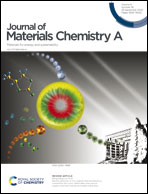Enhanced photocatalysis by light-trapping optimization in inverse opals
Abstract
Inverse opal photonic crystals with opal spheres of small diameters in the range of 70 to 170 nm have been widely adopted to enhance photocatalytic efficiency near the TiO2 conduction band, using the slow-light modes on the red (long-wavelength) and blue (short-wavelength) edges of the fundamental optical stop gap. We show that these two spectral regions have comparable light harvesting abilities, but neither of them are the optimum spectral range for photocatalysis in TiO2. Instead, the ideal resonant photonic modes are distributed among the higher order 5th to 15th photonic bands. By using larger opal spheres of ∼380 nm diameter, to place these higher order slow-light modes into the visible spectrum of 400 to 550 nm in lightly doped anatase TiO2, enhanced photocatalytic efficiency is possible. For an imaginary part of the dielectric constant 0.01, the maximum achievable photocurrent density reaches 2.09 mA cm−2 for a 6-layer inverse opal placed on a mirror substrate. This is 5.6 times the photocatalytic response of blue-edge slow photons near the TiO2 electronic band edge.



 Please wait while we load your content...
Please wait while we load your content...